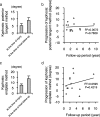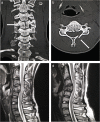Progression of local kyphosis after conservative treatment for compressive cervical spine fracture with spinal cord injury
- PMID: 30971275
- PMCID: PMC6458645
- DOI: 10.1186/s13018-019-1115-z
Progression of local kyphosis after conservative treatment for compressive cervical spine fracture with spinal cord injury
Abstract
Introduction: Compressive-flexion type cervical spine fracture is typically accompanied by apparent dislocation of the facet joints, undesirable cervical alignment, and devastating neurological dysfunction, which provides strong rationale for rendering prompt operative treatment. However, the validity of conservative treatment for compressive-flexion cervical spine injury in cases with preserved congruity of the facet joints has yet to be elucidated. The purpose of this study is to evaluate the long-term outcome of cervical alignment following conservative treatment for compressive-flexion cervical spine injury with preserved congruity of the facet joints.
Methods: A total of 662 patients who experienced spinal cord injury from 2007 to 2017 were included and underwent retrospective review in a single institute. Thirteen patients were identified as receiving conservative therapy following compressive-flexion cervical spine fractures with spinal cord injury. Clinical and radiological results were collected, including vertical fractures of the vertebral column, laminar fractures, progression of local kyphosis, and neurological status. The degree of the local cervical kyphosis was evaluated with two methods: the posterior tangent method and the endplate method.
Results: All 13 patients were male, and the mean age at the time of injury was 28.4 years. The mean follow-up period was 3 years. Although none of the patients presented neurological deterioration after the injury, the degree of local kyphosis was increased at the time of final follow-up compared to what was observed at the time of injury. Patient age at the time of injury and concurrent vertical fracture of vertebral body could have been influencing factors for the progression of the kyphosis. While laminar fracture affected the kyphosis at the time of injury, it was not a strong influencing factor of the overall progression of local kyphosis.
Conclusions: The conservative option for the compressive-flexion cervical injury allowed us to treat without exacerbating neurological symptoms as long as the facet joints are preserved. However, in terms of cervical alignment, surgical stabilization may have been desirable for these patients. Notably, the younger patients and the patients with vertical fracture of the cervical vertebral column in this type of injury required closer observation to help prevent the progression of local kyphosis.
Keywords: Cervical spinal cord injury; Laminar fracture; Local kyphosis; Vertebral fracture.
Conflict of interest statement
Ethics approval and consent to participate
This study was approved by the Ethical Review Board of Japan Labor Health and Welfare Organization Spinal Injuries Center. We had all the necessary consent from the patients involved in the study, including consent to participate in the study where appropriate.
Consent for publication
Written informed consent for publication of their clinical details and/or clinical images was obtained from the patient.
Competing interests
The authors declare that they have no competing interests.
Publisher’s Note
Springer Nature remains neutral with regard to jurisdictional claims in published maps and institutional affiliations.
Figures








Similar articles
-
[Features of the spinal cord injury in distractive flexion and compressive extension cervical spine trauma].Medicina (Kaunas). 2004;40(4):338-44. Medicina (Kaunas). 2004. PMID: 15111747 Lithuanian.
-
Traumatic subaxial cervical facet subluxation and dislocation: epidemiology, radiographic analyses, and risk factors for spinal cord injury.Spine J. 2018 Mar;18(3):387-398. doi: 10.1016/j.spinee.2017.07.175. Epub 2017 Jul 21. Spine J. 2018. PMID: 28739474
-
Comparative effectiveness of surgical versus nonoperative management of unilateral, nondisplaced, subaxial cervical spine facet fractures without evidence of spinal cord injury: clinical article.J Neurosurg Spine. 2014 Mar;20(3):270-7. doi: 10.3171/2013.11.SPINE13733. Epub 2014 Jan 3. J Neurosurg Spine. 2014. PMID: 24405465
-
Completely dislocated hangman's fracture with a locked C2-3 facet. Case report.J Neurosurg. 1997 Nov;87(5):757-60. doi: 10.3171/jns.1997.87.5.0757. J Neurosurg. 1997. PMID: 9347986 Review.
-
Pediatric cervical spine injuries: report of 102 cases and review of the literature.J Neurosurg. 2000 Jan;92(1 Suppl):12-7. doi: 10.3171/spi.2000.92.1.0012. J Neurosurg. 2000. PMID: 10616052 Review.
Cited by
-
Halo vest fixation effectively maintains cervical alignment through intraoperative repositioning in patients with cervical spine instability.Heliyon. 2024 Mar 15;10(6):e27952. doi: 10.1016/j.heliyon.2024.e27952. eCollection 2024 Mar 30. Heliyon. 2024. PMID: 38545194 Free PMC article.
References
Publication types
MeSH terms
LinkOut - more resources
Full Text Sources
Medical

